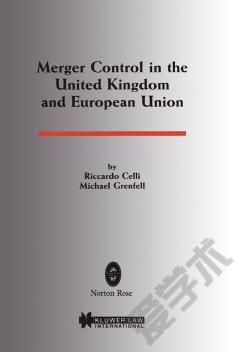Merger Control in Europe —— EU, Member States and Accession States
----- 欧洲的兼并控制:欧盟, 欧盟成员国及新加盟国家(第四版)
Merger control in Europe has continued to evolve rapidly. In addition to significant changes in the national merger control regimes in Denmark, France, Germany, the United Kingdom, and Portugal, a new EU Merger Regulation is expected to enter into force on 1 May 2004 - a measure that will launch the most far-reaching reform of European merger control since the adoption of the EC Merger Regulation in December 1989. This updated edition of the pre-eminent work in the field offers practitioners expert guidance through the next phase of this crucial aspect of business and economic activity in Europe.Like earlier editions, this new edition of Merger Control in Europe introduces practitioners and interested academics to the issues of merger control which are relevant when preparing an acquisition within the European Union. In order to provide insight into problem areas at each national level, and to allow possible comparisons, it includes a chapter on each of the 14 EU countries with a merger control regime, as well as one on the EU itself. In addition, as a first step towards the expected enlargement of the European Union in 2004, this new edition welcomes contributions on Hungary, Poland, the Czech Republic, and Cyprus.For each jurisdiction, the major elements of merger control law - the definition of concentration, control or notification thresholds, procedure, and substantive test clearance or appraisal, as well as other issues unique to each country - are all covered in some detail. For any of the jurisdictions, the practitioner will quickly be able to determine the precise scope of such important considerations as the following:? concept of concentration;? notification requirements;? procedural time-frame;? sanctions for violation of procedural rules;? special rules governing banks, building and loan associations, the media sector, insurance, and other specific areas of business;? political intervention possibilities;? publicity and confidentiality;? consultation of works council;? co-operation within the framework of the European Competition Authorities (ECA);? test for clearance;? economic benefits and disadvantages analysis;? what constitutes substantial lessening of competition;? remedies (both behavioural and structural); and? appeal against decisions regarding the test for clearance.Each chapter, written by one or more practising lawyers from major European law firms, is expertly grounded in the relevant law and takes into account changes in legislation and recent decisions. The book also contains a detailed introductory 20-page chart allowing readers to compare the basic elements of merger control law in all of the countries covered and in the EU.Like its three predecessors, this 4th Edition of Merger Control in Europe will quickly become the most relied-upon handbook in the field for business people and their counsel doing business in Europe.
{{comment.content}}








 京公网安备 11010802027623号
京公网安备 11010802027623号